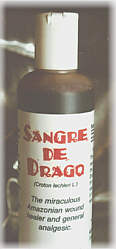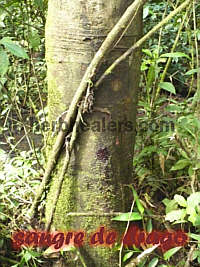
 angre de Drago
angre de Drago -- or
Dragon's Blood --
has been used for centuries as a wound healer, analgesic, and
cancer adjuvant -- to name a few of its benefits.
(
1 ).
Although it is native to parts of Africa, the
Canary Islands, and Socotra -- in addition to South America,
my experience is limited to the Western
Amazon and the species
Croton lechleri L..

In Ecuador, among indigenous
peoples I have met from Orellana in the North to Loja in the South,
Sangre de Drago is an indispensible healing agent among the
shamans and
curenderos of the Amazon region.

In spending time with
the Shuar, Woarani, Socoro, and numerous Quechuan speakers
of the Ecuadorean orient, I have found that few tribal peoples
of the Amazon do not know of this tree and its broad range
of medical properties.
This is probably why Dr. John Wallace of the University of
Calgary's Faculty of Medicine predicted that
every medicine cabinet
and first aid kit in North America will one day make use of it.
(
2 )
Uses & Protocols

The following uses and protocols
are well-established among the people's of the Ecuadorean orient.
Please note that these are indigenous uses, few of which have gone
through rigorous clinical testing. This ethnobotanical information
is provided as a guideline to how others use this variation
of
Sangre de Drago:

 Insect Bites
Insect Bites --
Pain relief comes in as little as 90 seconds and covers a broad
range of insects. Itching and swelling are rapidly alleviated.
 Burns
Burns --
For simple first degree burns, a few drops spread lightly over
the area works wonders.
 Sore Throat / Cough
Sore Throat / Cough --
Sangre de Drago is anti-bacterial and anti-viral. A common use
for sore throat is to take just one drop -- sublingually.
For a nagging cough, a half teaspoon (2.5 ml.) twice daily
in a small glass of water is usually sufficient to gain
relief.
 Ulcers, Gastrointeritis
& Other Infections of the Gastrointestinal Tract
Ulcers, Gastrointeritis
& Other Infections of the Gastrointestinal Tract -- One
half teaspoon, 3 times per day, for up to 12 days or "until cured."
 Urinary Track Infections
Urinary Track Infections --
One half teaspoon in water, one to three times a day based on
severity, until eliminated.
 Premenstrual Cramps
Premenstrual Cramps --
One half teaspoon with water, three times a day, for relief.
Helps regulates periods.
 Menstrual Period Regulation
Menstrual Period Regulation --
One half teaspoon, in pure water, taken in the morning.
 Cancer
Cancer --
For reasons that are not clear even to this author, among the
many cancer remedies that are used in the Amazon, this variety
of
Sangre de Drago is used primarily for cancers of the
reproductive organs only: prostate, testicular, and penis in
men; cervical, uterine, and vaginal in women. I have been repeatedly
told that this is where they are most efficacious in cancer
cases. Protocol: 5 drops in a small glass of water (not juice!),
three times per day.
 Improved Heart Health
Improved Heart Health --
Most of our information comes from the ethnobotanical literature, but there is
clinical data supporting the use of "Sangre" to improve heart health.
By way of example, see:
Dragon's Blood exerts cardio-protection against myocardial injury
through PI3K-AKT-mTOR signaling pathway in acute myocardial infarction mice model.
 Post Eschar Anti-Scarring
Post Eschar Anti-Scarring --
We have been experimenting with
Sangre de Drago in
the healing of eschars created through the use of Cansema.
My interest in this stemmed from the fact that there is a
greater occurrence of keloidal scarring with the use of
escharotics in South America and Africa. We had
some success
with
Tru-Derm Anti-Scar Cream
prior to the FDA raid, but based on its ancient and common usage
on wounds of all types to prevent scarring
before
it occurs, we are testing for this application now.
(Incidentally, a different remedy is used in the Amazon to
remove scars
after they occur: Oil of Canela
("Ishpingu" in the Pastaza Quechuan dialect).
Recommended Video Short on Sangre de Drago

The following video is recommended:
 Harvesting Sangre de Drago
Harvesting Sangre de Drago --
I've harvested
Sangre de Drago myself . . . so I can tell you,
this 0:26 shortie gives you a glimpse of how its done in small amounts.
In commercial applications, a larger vessel is set against the tree
-- much as maple syrup is collected.
